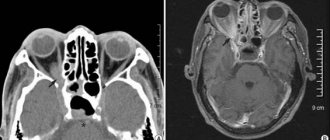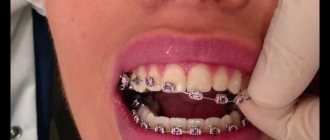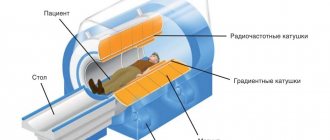The medical term “B-scan” is used to refer to a non-invasive diagnostic method that uses ultrasound waves. Another name for it sounds like “ultrasound of the orbit of the eye.” The technique is highly informative and has proven itself in identifying eye diseases. At the same time, it is less accurate than the A-scan.
Based on the results of its implementation, the ophthalmologist can determine not only the location, shape and size of the neoplasm, foreign body, opacities and other types of pathological foci, but also determine their effect on other ocular structures. B-scanning has found wide application in ophthalmology as an independent diagnostic method, as well as within the framework of complex diagnostics.
If you don’t know where to get an eye ultrasound in Moscow, contact the Sfera ophthalmology clinic. Our patients always get the best! We have everything necessary for this: experienced specialists, a powerful diagnostic base and a desire to help our patients regain their vision.
What does an ultrasound show?
Ultrasound diagnostics makes it possible to obtain comprehensive information about the condition of the eyeball and possible pathological phenomena occurring in it. The procedure is based on the action of ultrasonic waves that are reflected from the areas under study. A special device catches these waves and converts them into information, which is deciphered by specialists. Diagnostic results show:
- movements carried out in the eyeball;
- structure of the eye muscles;
- condition of the optic nerve;
- blood circulation speed;
- orbital parameters;
- degree of vascular permeability;
- parameters of the ocular vessels.
This type of diagnosis allows you to detect tumors, if any, and determine their nature. You can also diagnose the degree and type of detachment. All pathological formations are diagnosed even at the initial stage. The advantages of the procedure are its accessibility, high quality and information content, and the absence of side effects. If you have doubts or fear, you can watch a video about the method of performing an ultrasound of the eyeball.
What is retinal ultrasound?
Ultrasound diagnostics is based on the principle of converting echo signals received from ocular structures, followed by obtaining an image in “2D” format. Thus, the attending physician receives a complete picture of the condition of the fundus and tissues. It can determine the anatomical structure of the eye muscles and identify any abnormalities in the structure of the retina.
Ultrasound of the eyelid and other structures is performed not only for diagnostic, but also for preventive purposes after or before surgery. In the first case, it allows you to evaluate the results of treatment, in the second - the risks and scope of surgical intervention.
One of the advantages of the technique is the ability to obtain volumetric indicators. Modern scanners are often equipped with additional modules that allow measurements of the structures of the eye and the distance between its anatomical formations. The results of the study do not depend on the degree of transparency of optical media, so it can be used for pathologies characterized by clouding.
Indications for eye ultrasound
Ultrasound of the eyes is prescribed both for the diagnosis of eye diseases and for the prevention of their formation. There are many reasons for conducting this type of research. Indications for which research is recommended:
- tumor in the eyeball, to determine its nature and location;
- ocular trauma, to determine the extent of the lesions;
- when a foreign body gets into the eye, to detect its exact location;
- eye diseases such as glaucoma, cataracts, retinal dystrophy or detachment;
- visual impairment: farsightedness or myopia;
- impaired quality of vision;
- diseases associated with the optic nerve;
- tumor of various etiologies inside the eye;
- destructive processes and adhesions in the vitreous body;
- fundus examination;
- monitoring the condition of the eye after surgical procedures;
- determining the thickness of fatty tissue;
- abnormal structure of the eye, in order to determine the degree of pathology.
Using the ultrasound diagnostic method, they study how effective a particular method of treating eye diseases is. An ultrasound of the eye shows that in the presence of diseases such as diabetes, hypertension, or if there are problems with the kidneys, an ultrasound is prescribed to study the fundus of the eye.
Indications
Ultrasound of the eye is one of the diagnostic methods recommended for patients with myopia or farsightedness.
Ultrasound of the eye may be prescribed in the following cases:
- high degrees of myopia or farsightedness;
- cataract;
- glaucoma;
- eye tumors;
- retinal disinsertion;
- pathologies of the eye muscles;
- suspicion of a foreign body;
- optic nerve diseases;
- injuries;
- vascular pathologies of the eyes;
- congenital abnormalities of the structure of the visual organs;
- chronic diseases that can lead to the appearance of ophthalmological pathologies: diabetes mellitus, hypertension, kidney disease accompanied by hypertension;
- monitoring the effectiveness of treatment of eye cancer pathologies;
- monitoring the effectiveness of therapy for vascular changes in the eyeball;
- assessment of the effectiveness of ophthalmological operations performed.
Doppler ultrasound of the eye is indicated for the following pathologies:
- spasm or obstruction of the retinal artery;
- thrombosis of the ophthalmic veins;
- narrowing of the carotid artery, leading to impaired blood flow in the ophthalmic arteries.
Ultrasound of the eye can be prescribed to all categories of patients and has no age restrictions. It can be performed on children of any age, elderly people, women during pregnancy or lactation, and patients with severe concomitant diseases.
Types of ultrasound examination
The ultrasound procedure can be performed in different modes. Ultrasound of the eyes how is it done? There are several options:
- A-mode.
- B-mode.
- A+B mode.
- Three-dimensional study.
- Color duplex.
A-mode is a one-dimensional image that allows you to study the condition of the eye tissues and make the measurements required for the operation. This type of research is carried out extremely rarely.
Mode B allows you to obtain a two-dimensional image of the eyeball. Using this type of ultrasound, the internal structure of the eyes is examined. This method is more common.
A comprehensive A+B study combines the advantageous characteristics of both types of diagnostics.
Three-dimensional echo-ophthalmological examination allows you to study the condition of the eye in detail, conveying its three-dimensional image. Using this method, static dimensions are studied, as well as changes in curvature relative to the movement of the scanning plane, and information about the vascular system can also be obtained.
Color duplex scanning is used for:
- studying the state of the eyeball using its two-dimensional image;
- blood flow velocity measurements
- studying the nature of ocular blood circulation.
Using this method, vessels of different sizes are examined: from the smallest capillaries to large ones.
How to prepare for a session
Ultrasound examination of the eyeball is prescribed to identify diseases, especially in the early stages of their development.
Ultrasound of the eyes is performed in specialized centers and clinics. No hospitalization required. It takes from 15 to 35 minutes.
In order for the study to show correct, undistorted results, you need to properly prepare for it.
The woman must remove all makeup from the eyes and the area around them, a special gel will be applied to the upper eyelid, and the makeup will be damaged during the procedure.
Young children need to be told in advance, preferably shown, how the procedure is carried out (there are many videos on the Internet), this will help them psychologically adjust and not be afraid of the examination.
Contact lenses and glasses will have to be removed.
It is important to inform your ophthalmologist about allergic reactions to local anesthetics if scanning is performed in A mode.
What are the contraindications?
There are no contraindications for the study; it is completely safe.
Ultrasound can be performed on pregnant women, nursing mothers, children and the elderly. Diseases of a hematological nature and oncological diseases do not interfere with the examination.
The method is prescribed with caution in the following cases:
- injured eyeball, eyelid;
- open wound of the eye and adjacent tissues;
- hemorrhage in the retrobulbar zone;
- inflammation of the eyeball;
- bleeding, burns of facial tissue.
Progress of the procedure, how to do an ultrasound of the eyes
The method of performing the procedure depends on the mode in which the eye is diagnosed.
If the examination is carried out in A-mode, the patient is seated on the left side of the specialist. To anesthetize the eye and make the diagnostic session easier, an anesthetic is instilled. Then they proceed directly to the procedure: the sensor is moved along the mucous membrane of the eye.
B-mode differs in that scanning is performed with the eye closed. In this case, there is no need to drop medication into the eye. Gel is applied to the eyelid so that the sensor can move across it easily. The session takes no more than 15 minutes in total. After the procedure, the evil eye gel is removed using a napkin.
How is an ultrasound of the eye done and its types?
Ultrasound is performed using a special device.
The patient is in a reclining position or lying on the couch. A special gel is applied to the closed eyelid, allowing the sensor to glide over the skin and transmit a signal to the monitor. Sometimes a special solution is dripped into the eye, and after its effect begins, a sensor is placed on the eyeball. During the procedure, it is forbidden to move, this may distort the result.
The gel is removed from the eyelid with a napkin, the effect of the solution wears off on its own.
The quality and clarity of the study will depend on the capabilities of the ultrasound machine.
There are several methods for ultrasound examination of the eye:
- Ultrasound diagnostics in mode A (echobiometry);
- B-mode examination (echography);
- three-dimensional study of the eyeball (echoophthalmography);
- Duplex ultrasound scanning (Dopplerography).
Echobiometry is a rarely used research method. Performed before surgical procedures. The essence of the technique is as follows: anesthetic drops are instilled, and a sterile sensor is passed over the open eye.
Dopplerography evaluates blood flow in the area of the eyeball, features of the vessels and capillaries of the organ.
Based on the results, the sonologist fills out a special protocol, which is given to the patient. The ultrasound examination can be interpreted by the specialist who issued the referral for examination.
A- and B-modes
A- (one-dimensional study) and B- (two-dimensional echography) modes are carried out on a closed eyelid, separately or together.
One-dimensional scanning is performed to study the size of the organ, assess its individual structures and eye orbits. The examinee is on the left side of the sonologist. An anesthetic is dripped into the eye to ensure immobility, and a graph of the eye parameters is plotted using a device installed on the organ. The horizontal axis draws the distance to certain organ tissues per unit of time. The vertical axis displays the echo amplitude and strength.
A two-dimensional examination is carried out to study the internal structure of the eyeball. The specialist moves the sensor over the eyelid, and the signal wave is transmitted to the screen in the form of multi-colored dots of different saturation.
Combining the two modes shows a detailed picture of the organ's condition. If necessary, the methods are combined to study the vascular system of the eye.
Doppler scanning of blood vessels
Scanning of blood vessels using energy (study of the amplitude and speed of blood flow) or pulsed wave (analysis of noise in the vascular network of an organ) Dopplerography.
Based on the results of the analysis, the specialist evaluates the characteristics of blood circulation.
Doppler ultrasound examination, or USDG, of the blood vessels of the orbit of the eye is prescribed if the following abnormalities are suspected:
- spasms of the retinal arteries and vascular obstruction;
- blood clots in the ophthalmic veins;
- narrowing of the lumens of the carotid artery.
Decoding the results
The final results are deciphered by the attending eye doctor; he also uses information received from the sonologist. In the absence of pathology, the results will look like this:
- the lens should not be noticeable; in its normal state it remains transparent, but its posterior capsule should be visible;
- The vitreous body should also be transparent;
- if there is no pathology, then the axis length should be from 22.4 to 27.3 mm;
- thickness of the inner membrane of the eye is from 0.7 to 1 mm;
- width of the optic nerve 2 - 2.5 mm;
- The vitreous body axis (antero-posterior) is about 16.5 mm, volume is 4 ml.
As for the refractive power of the eye, these indicators will normally correspond to from 52.6 to 64.21 D.
Diagnostic methods
Ultrasound diagnostics is based on echolocation - the reflection of high-frequency sound waves from an object. The ultrasonic transmitter sends acoustic waves, the information from the reflection of which is visualized on the monitor.
The ultrasound examination procedure does not require prior preparation or adherence to any diet. Women are not recommended to apply makeup to their eyelids and eyelashes, as the device requires a special gel to be applied to the eyelids.
There are several hardware examination methods:
- Ultrasound biometrics;
- A-mode (echobiometry);
- B-mode (echography);
- A + B mode;
- biomicroscopy;
- three-dimensional echoophthalmography;
- color duplex scanning;
- Ultrasound duplex scanning.
One-dimensional A-mode determines the characteristics of the tissues of the eyeball, allowing measurements of the eye, orbit and orbit. This procedure is usually performed before elective surgery.
B-mode determines the internal structure of the eyeball. A + B scanning gives a complete characteristic in one-dimensional and two-dimensional modes, shows the features of the structural structure of the orbits. 3D echoophthalmography shows the eye in three dimensions along with a real-time characterization of the vasculature.
Biomicroscopy provides a clear image of the examined organ, thanks to digital processing of the echo signal. Color scanning allows you to see the movement of blood flow in the vessels, the speed of blood flow and the pathology of the vascular system.
There is also a pulsed wave Doppler method, which is based on noise scanning. Based on the nature of the noise, the ophthalmologist determines the presence/absence of circulatory pathologies in the eyeball.
Duplex ultrasound scanning combines all of the above methods and allows you to examine the eyeball in all parameters at once: size, structure, blood flow speed.
Ultrasound biometry is performed to select contact lenses; it characterizes the shape of the eyeball, lens and cornea. This method is also used to collect additional information in the presence of glaucoma. Biometrics is prescribed to determine the causes of myopia or hyperopia.
Tips and tricks
Ultrasound examinations are carried out both in multidisciplinary diagnostic centers and in highly specialized ophthalmological clinics. Where to do an ultrasound of the eyes, the patient independently decides which institution to undergo diagnostics and which specialist to trust.
Before contacting a particular diagnostic center, you should consult an ophthalmologist for advice. Despite the fact that this procedure is safe for health, there are still some contraindications. Particular caution should be exercised by persons whose ocular environment is completely or partially clouded.
Overall, the procedure can be relatively inexpensive. Ultrasound eyes price average cost is 1,300 rubles. In some cases, you will have to pay up to 5,000 rubles for diagnostics. The cost depends on the category of ophthalmological hospital and the classification of doctors.
Contraindications for sonography
Ultrasound is not performed for people with eye contusion (retrobulbar hemorrhage), injury or burn to the eyelids, or severe trauma to the visual organs. In other cases, the ophthalmologist assesses the degree of damage and prescribes sonography or another diagnostic method. Before the procedure in mode A, sensitivity to anesthetics is checked.
There are no age-related contraindications for ultrasound of the eyes and orbit. The procedure is allowed for newborns, lactating or pregnant women.
Patient reviews
Everyone who has undergone an ultrasound examination notes that this is a fairly informative diagnostic method. The process itself does not take much time and does not require any special preparation before it is carried out.
The only inconvenience is that the results obtained during the study are not interpreted on the spot. To do this, you will need to additionally contact a qualified ophthalmologist, who will make a diagnosis and prescribe the necessary treatment.
If there are serious eye diseases, a timely ultrasound procedure will help avoid complications and loss of vision. A video about the method of performing an ultrasound of the eyeball can be found on the Internet.
Indications for use of this method
Know! Unlike other narrowly focused types of ophthalmological examinations, ultrasound of the eye has a wide range of indications and allows us to identify most known diseases and pathologies of the eye, including:
- cloudiness of various types;
- the presence of foreign bodies in the organs of vision with the ability to determine their exact size and location;
- neoplasms and tumors of various types;
- farsightedness and myopia;
- cataracts;
- glaucoma;
- lens luxation;
- optic nerve pathologies;
- retinal detachment;
- adhesions in the tissues of the vitreous body and disturbances in its structure;
- injuries with the ability to determine their severity and nature;
- disorders of the eye muscles;
- any hereditary, acquired and congenital anomalies in the structure of the eyeball ;
- hemorrhages in the eye.
In addition, ultrasound examination makes it possible to determine changes in the characteristics of the optical media of the eye and estimate the size of the orbit.
Ultrasound also helps to measure the thickness of fatty tissue and its composition, which is necessary information when differentiating forms of exophthalmos (“bulging eyes”).
Indications for research
Indications for ultrasound of the eyeball are:
- preoperative or postoperative period;
- identification of blood clots, determination of their volume, localization;
- violation of the integrity of the vitreous body;
- eye control for diabetes;
- presence of bulging eyes;
- pathological foci of the optic nerve, motor muscles;
- threat or fact of detachment of the inner membrane of the eye;
- glaucoma;
- cataract;
- a sharp decrease in visual acuity;
- presence of a foreign body;
- high myopia;
- diagnosis of neoplasms and monitoring them.
Ultrasound readings are also based on assessing the condition of the cornea and lens
How the research is carried out
During the procedure, the patient is in a sitting or lying position, and an anesthetic substance is instilled into the organ of vision to immobilize the eyeballs and reduce possible pain. Then a scanner equipped with several sensors is passed over the surface of the eye. Type A ultrasound is performed in a similar manner.
Examination in B mode is carried out a little differently. The scanner is passed over the eyes closed; in this case, no anesthetic is required. The eyelids are lubricated with a special conductive substance; after completion of the procedure, the remaining gel is removed with a napkin. During the examination, the patient should remain motionless and try to move the eyeballs to a minimum. The result of the procedure is recorded in the patient’s outpatient card.
| Modern equipment examines well the internal structure of the visual apparatus and displays a clear image on the screen. The display reflects the condition of the cornea and its main characteristics (thickness, curvature, etc.). |
Return to contents
Contraindications, preparation for the study
Ultrasound diagnostics of the eye is based on the principle of echolocation. This is a method for determining diseases of the organ of vision, which has many advantages: harmlessness, simplicity and convenience, affordability of the service. An important advantage is painlessness, since there is no need for injections or incisions.
Ultrasound diagnostics of the eye can be performed on patients who do not have the following contraindications:
- penetrating eyelid wounds
- damage to the eye in which the integrity of the structures is damaged
- bleeding
There are no other contraindications. Therefore, ultrasound diagnostics of the eye is widely used in private clinics and public medical institutions. It is used to identify tumors, congenital features of the organ of vision, and inflammatory processes. Research recommends for adults, children, and pregnant women.
Ultrasound diagnostics of the eye is carried out as prescribed by a doctor in the presence of diseases. It is also possible to conduct research for preventive purposes. This prevents the development of many eye diseases.
No special preparation is required for the diagnostic procedure. A special rule applies to representatives of the fair sex. Before conducting the study, you need to remove your makeup because the sensor is placed on the upper eyelid.
Do children need an ultrasound?
Additional diagnostics are prescribed if examination using a slit lamp does not provide a complete picture of the condition of the visual system. Using ultrasound, the doctor obtains the necessary information about the fundus of the eye and can detect congenital abnormalities. The procedure allows you to prevent the development of myopia in children and identify a number of ophthalmological ailments, for example, improper formation of the floor of the orbit.
The study can be carried out at a district clinic or at a private medical center. The price for the procedure is about 1200 rubles. After the ophthalmologist receives a transcript of the diagnostic results, he selects the optimal treatment option (if necessary).











